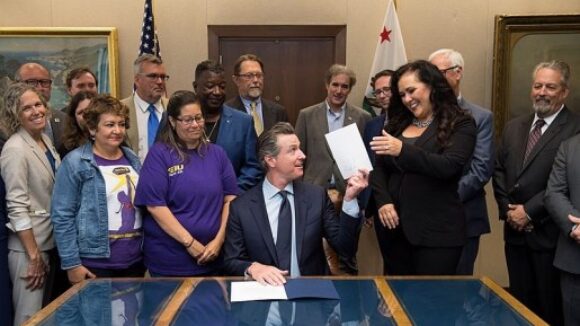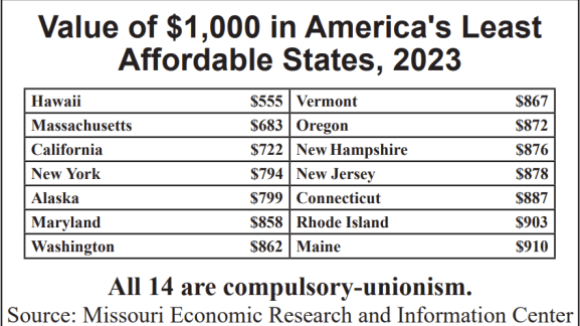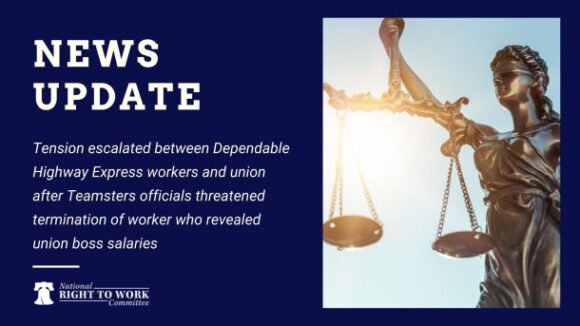This is an important story in these times of Big Labor’s takeover of the Federal government. This documented true story that contains Card Check abuse, SEIU physical violence against workers, SEIU abuse of the NLRB system, orchestrated false allegations, and a corrupt Clinton appointee; and you can see and hear about what happens when Big Labor Bosses control a president’s administration like they do today.
Mr. Randy Schaber’s story begins with the discovery of an ongoing SEIU Card Check Forced Unionism scheme that included harassing employees at their homes. Mr. Schaber offered to hold an NLRB sanctioned secret ballot election.
The SEIU organizers replied, “We will never let your employees have a secret ballot election.” Then, Mr. Schaber began to feel the pain that SEIU’s corporate campaign is designed to inflict.
Randy’s employees were physically assaulted during this SEIU organizing campaign.
To hear Mr. Schaber tell the story in his own words, we recommend that you listen and watch his full interview (click links to video clip 1, video clip 2, and video clip 3); for a brief description view his shortened interview. You will be amazed at the abuse of federal power coordinated by SEIU in the 1990’s when they had less control of the White House than they do today.
For more information, you can download the edited version of the U.S. House of Representatives Report and the U.S. Department of Labor Inspector General’s Report that discuss SEIU’s corporate campaign and the U.S. Department of Labor’s abuses that Mr. Schaber suffered, and it eventually resulted in the dismissal of a Clinton appointee.
The following are quotes from that U.S. House of Representatives report:
Abuse of power at the Department of Labor
CONCLUSION
Based on the Office of the Inspector General’s investigation and the testimony of other witnesses at the hearing, it is obvious that Mr. Richard F. Sawyer abused his position as the Secretary’s Representative by intervening on behalf of the SEIU in its campaign to organize the janitorial workers of Somers.
This information establishes several irrefutable facts:
(1) Mr. Sawyer contacted officials of Somers’ largest client, and specifically discussed the Department of Labor’s active and on-going investigation of Somers.
(2) Mr. Sawyer contacted the Department of Labor’s Wage and Hour investigators to request information on the status of the Somers’ investigation and to complain about the progress of said investigation.
(3) Mr. Sawyer improperly provided the SEIU with specific information regarding the Department of Labor’s active and on-going investigation of Somers—information that was used by the SEIU both privately and publicly to pressure Somers to capitulate to the union’s organizational demands.
(4) Mr. Sawyer contacted high-ranking officials within the Wage and Hour Division’s national office to complain about the progress of the Somers’ investigation.
(5) In response to Mr. Sawyer’s repeated contacts, high-ranking officials within the Wage and Hour Division’s national office assigned five additional investigators to the Somers’ investigation and directed investigators to give Somers special attention.
(6) The Somers’ investigation was kept open well beyond the point the lead Wage and Hour investigator deemed warranted by the facts.
(7) Despite the involvement of no less than six investigators and 500 hours of investigative work, the Wage and Hour Division discovered only $317.44 in FLSA violations.
These facts clearly illustrate that Mr. Sawyer was engaged in a conscious effort to use his position as the regional representative of Labor Secretary Robert Reich to assist his former employer, the SEIU, in its efforts to organize the janitorial workers of Somers. As such, the Subcommittee believes it wholly appropriate that Mr. Sawyer’s employment with the Department of Labor was terminated.
The Subcommittee also remains concerned about the extent to which other Department of Labor employees had knowledge of, supported or assisted Mr. Sawyer in his efforts to coerce Somers into signing a union contract with the SEIU. As noted previously, Mr. Sawyer’s position as a Secretary’s Representative falls under the purview of the Office of Congressional and Intergovernmental Affairs and his official Department of Labor job description clearly states that the ‘‘Incumbent reports directly to the Director of the Office of Intergovernmental Affairs * * * [and] consults with the Director on decisions or matters which appropriately require personal attention.” Based on this description of Mr. Sawyer’s supervisory controls, it is reasonable to expect that high-level Departmental officers, like the Director of the Office of Intergovernmental Affairs, would have been aware of Mr. Sawyer’s actions concerning Somers.
It is also reasonable to assume that Ms. Geri Palast, Assistant Secretary of Congressional and Intergovernmental Affairs, would also have knowledge of Mr. Sawyer’s actions. If not, the Subcommittee cannot help but question the efficacy of the Department of Labor’s supervisory controls with respect to the Secretary’s Representatives.
Corporate campaigns
John Sweeney, President of the AFL–CIO, declared a new direction for the international labor unions that the Federation represents. Mr. Sweeney declared that labor would become far more militant in the pursuit of organizing and collective bargaining objectives. The term used to organize formally non-union corporations became known as ‘‘corporate campaigns.’’
A ‘‘corporate campaign’’ has several distinct elements. Two of the most prominent elements are: having the target company perceived negatively by the company’s investors, customers, employees and the public, and initiating enforcement and oversight actions by federal, state, and local governmental agencies. In other words, organized labor in a ‘‘corporate campaign’’ does not necessarily target the employees of the corporation as it had done historically, but rather focuses on corporate management.
Perhaps Stephen Lerner, Organizing Director of the Service Employees International Union, said it best –
Instead of asking, ‘How do we win a majority of (employee) votes?’, we should be asking, ‘How do we develop power to force employers to recognize the union and sign a contract.’
During the course of the 104th Congress many concerns were raised by targeted corporations regarding the tactics used by organized labor and their attendant relationship with the NLRB. Employers argued that the NLRB was favoring organized labor and was indeed a willing pawn in the ‘‘corporate campaign’’ strategy. As a result of these repeated and serious allegations, the Subcommittee conducted two hearings and one round-table discussion.
The first hearing held by the Subcommittee invited NLRB Chairman Gould, General Counsel Feinstein, and a variety of small and large employers to recount their personal experiences. The second hearing held by the Subcommittee focused on the ‘‘corporate campaign’’ technique of salting – the placing of professional union organizers or members in a nonunion facility to harass or disrupt contractor operations, to increase costs, or to organize.
These two hearings raised a number of concerns for the Subcommittee including the following:
- Organizing nonunion employees into a unified union membership is not necessarily the objective of union organizers;
- Resources are not an obstacle for the unions when it comes to public relations;
- The cost of frivolous complaints and other federal agency charges fall on the businesses and the federal taxpayer while the unions have no direct accountability or cost; and
- Jeopardizing jobs and employer viability is ultimately more important than ensuring that workers have good wages, safe worksites and fulfilling jobs.
In conclusion, the pursuit of injunctive relief, the NLRB’s handling of ‘‘salting’’ cases and the public comments of the NLRB Chairman have served as ample evidence that the NLRB may be biased against the regulated employer community.
(REPORT ON THE ACTIVITIES OF THE COMMITTEE ON ECONOMIC AND EDUCATIONAL OPPORTUNITIES DURING THE 104TH CONGRESS, 1/2/1997)


